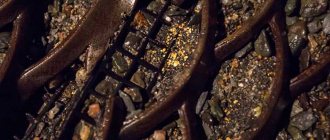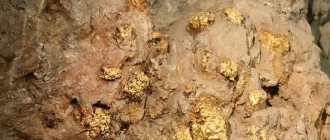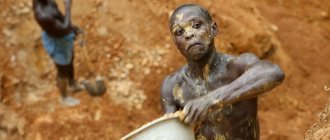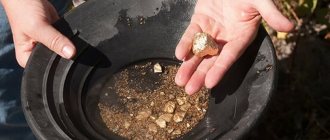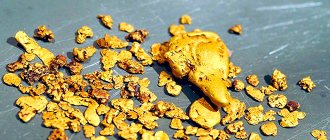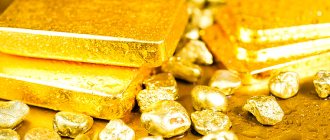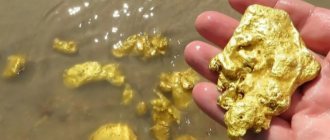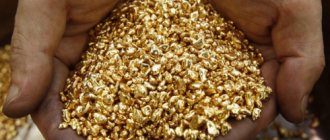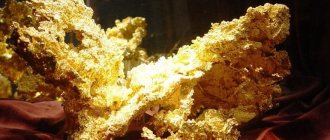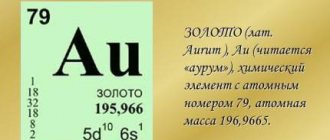- September 17, 2019
- Directions
- Victoria Samarskaya
This article will be useful to those who are interested in where gold is mined in Russia: cities, deposits, enterprises. Our country is among the top three in mining the yellow metal, second only to China and Australia. Most of the mines are geographically located in the southern and central regions of our country.
Major gold mining companies
We list the largest ones that provide industrial production of the yellow metal:
- PJSC Polyus, spun off from OJSC Norilsk Nickel in 2006. The main owners are Suleiman Kerimov (37% of shares) and his family. This is one of the world's largest enterprises engaged in gold mining in the Irkutsk, Krasnoyarsk, Magadan and Amur regions. Based on the geography of the company's mines, you can understand where gold can be found in Russia.
- Kinross Gold is an international company headquartered in Toronto. On the territory of the Russian Federation, it is developing the Kupol field in Chukotka (Anadyr region).
- JSC "UGK" is a group engaged in gold mining both open and closed methods in the Krasnoyarsk Territory, Chelyabinsk Region and the Republic of Khakassia.
- PJSC Severstal, which separated gold mining assets into an independent enterprise Nordgold, which has international status. Owns five mines in the Russian Federation (Amur Region, Buryatia, Republic of Sakha).
- JSC Polymetal, which ranks second in Russia in terms of gold production. Its deposits are located in the Urals, Chukotka, and Magadan region.
- PJSC "Vysochaishy" It was created to develop the Golets Vysochaishy mine (Irkutsk region), but also mines the yellow metal in the Republic of Sakha.
When a license is not required
A gold license may not be required in the following cases:
- purchase or lease of an enterprise with all permits. In this case, it will be necessary to obtain a re-evaluation of the geological information about the deposit from government inspectors;
- work by agreement on the dumps of a gold mining enterprise. Private individuals can legally mine precious metals by concluding an agreement with gold mining companies. Often companies sell for a certain percentage the opportunity to develop their subsoil or areas where deposits do not allow for industrial production. But it is quite difficult for beginners to cooperate with such companies. More often than not, all the “good” sites are taken apart by former employees and partners of companies.
About the extraction of yellow metal by private owners
You can often hear the question of where private owners mine gold in Russia. Many experienced a period when any person, practically without any official permission, could engage in mining and washing yellow sand. This is the 90s: from 1992 to 1998. Today, illegal mining is subject to a large fine and confiscation of equipment. There is also criminal liability for storing reserves worth more than 1 million rubles. Despite the ban, up to 10% of production comes from illegal gold miners.
But from 2021, individuals have the opportunity to obtain a license to develop small plots (150 thousand sq. m). To do this, you need to register an individual entrepreneur. Private owners have many restrictions: the license period is 5 years, miners do not have the right to use hired labor and heavy equipment. Extraction is carried out exclusively by hand. The Rosnedra agency has a register of vacant sites, but official registration of prospectors is proceeding slowly. The point is taxation (on profit and production), as well as the need to carry out exploration ourselves and take care of safety.
Where does gold come from?
Metals with an atomic mass of more than 55 units (heavier than iron), which cannot be formed inside stars, arise as a result of gamma-ray bursts - releases of energy in space during supernova explosions. Gold came to Earth with asteroids many years ago, when our planet was just being formed and had no atmosphere. Most of the heavy elements sank below the Earth's surface and formed the core.
There are few precious metals on the surface. Their main volume is located in the mantle - the substance between the earth's crust and core. In the upper layers of the mantle, a hot melt is formed - magma, which in some places penetrates the surface of the Earth. There it hardens and turns into solid rock, containing almost the entire periodic table.
Magma is heterogeneous, hardens unevenly - refractory substances coexist with low-melting substances, and the latter continue to circulate inside the solidified former. This is how gold veins are formed within the rock.
Where is gold mining done?
If a person is puzzled by the question of where to mine gold in Russia himself, then he should contact the Rosnedra agency for the allocation of a free plot. The most promising ones are those where existing mines were previously located. Thus, in the Amur region, a deposit in which gold mining has been carried out since the 19th century has been closed. Surely there is something to profit from there today.
Areas that are currently being developed industrially using heavy equipment are also considered promising. Private owners have the opportunity to enter into agreements with large companies, which, for a certain percentage, allow mining of the yellow metal in territories that are inconvenient for them. Such large testing grounds are located in Yakutia and the Urals. Dense soils are considered the most promising, which is why most prospectors are in the east of the country and in the taiga. Where in Russia are deposits of precious metals located?
Use of precious metal in various industries
The main industries in which this metal is widely used are:
- jewelry industry;
- creation of modern electrical appliances;
- optics;
- medicine;
- cooking;
- atomic research;
- production of weapons of mass destruction.
Only a tenth of the extracted noble element goes into industry, about 45% ends up in the gold and foreign exchange reserves of states and private individuals. The rest of the metal is used to make jewelry.
Geography of gold mining
On the map just above you can see that most of the gold deposits are located in the Urals and beyond the Urals. In the central part there are only three gold mining provinces. We are talking about the Karelo-Kola, Caucasian and Dnieper-Don zones. The main reserves of the yellow metal are represented in the Asian territory of the Russian Federation. When asked where gold is mined in Russia, any representative of this industry will name Chukotka, Amur, Magadan, Bodaibo, Taximoto and the Urals. By the way, one of the largest nuggets was found in Bilibino (Chukotka). His weight was 16 kg. Let us list the most famous deposits where work is being carried out today.
Modern technologies
Finding gold usually takes a long time. Sometimes they last for years and often without success. To properly organize the work, the digger must study the necessary literature and have special equipment. Everything together will contribute to a more productive and accelerated process.
Previously, gold was mined manually, panning it using trays. Today, large mechanisms with a large number of trays are used for this purpose. Such devices are called dredges; they flush water from the river. This design is designed to extract precious metal from river rock.
When working with rocks, gravity differentiation technology is used. After extraction, the composition is taken to special mills, where it is crushed under the pressure of large balls of strong cast iron. The resulting mass is sent to a centrifuge to separate pyrite. It contains particles of gold.
More modern technologies make it possible to extract gold from almost empty mines, but such methods are unlikely to be suitable for the average miner. Many people use a metal detector, which reduces search time and increases work efficiency.
Magadan Region
This region is the leader in alluvial gold mining, although there are also ore deposits here. The development of deposits began in the region only in the 30s. XX century, and today there are already more than 547 deposits in Kolyma. They produce 14-17 tons of placer gold per year. We list the largest deposits:
- “Natalkinskoe” (Tenkinsky district, Omchak river). Discovered in 1942, it provides 79% of all gold reserves in the region.
- “Pavlik” (Tenkinsky district, near the village named after Gastello). Discovered in 1942, it provides 7.3% of the yellow metal reserves.
- "Perekatnoe" (North-Evensky district). Discovered in 1961 (5.7% of gold reserves).
If we are interested in where prospectors mine gold in Russia, then we should know: it is in this region that about 12 small deposits are listed in the undistributed fund. Their reserves are estimated at 356 tons. Therefore, private owners most often flock to Kolyma for success.
Bedrock deposits
Such formations of gold appeared as a result of the movement of magma during a period of volcanic activity. Magma contains much more of this metal than the earth's crust.
Magma, escaping from the depths, gradually solidified, as a result of which minerals were formed. If the elements had increased refractoriness, they crystallized, and low-melting substances moved on. But not only gold has a low melting threshold; there were also other elements, the combination of which formed a chemical complex of substances. Therefore, in the area of primary deposits it is difficult to find gold in its pure form. Typically, compounds where there are gold inclusions consist of a combination of iron, copper, lead and zinc.
Because As a result of volcanic activity, mountains were formed, then gold must be looked for in mountainous gold-bearing areas.
Chukotka
The autonomous region has taken 2nd place in the Russian Federation in gold mining. In total, approximately 25 tons of yellow metal are mined here every year. Mostly ore. The largest deposits are:
- “Dome” (border of Bilibinsky and Anadyr districts). Opened in 1991. Mining is carried out using both open-pit and open-pit mining methods. The depth of the quarry is 90 m. Its reserves are estimated at 65.5 tons.
- "Double" (Bilibinsky district). Opened in 1983. Reserves are estimated at 37 tons.
Both deposits are gold-silver. The region has many inaccessible places, so there are a large number of black miners active here. This is about the question of where gold can be mined in Russia.
Features of placer deposits
Placer deposits are called secondary, the reason for this is the peculiarities of the process of their formation. Placer gold deposits are formed from primary deposits as a result of ongoing physical and chemical impacts. The action of winds, temperature changes, precipitation, the movement of groundwater, the vital activity of microorganisms and plants over a long period of time gradually leads to the destruction of rock. The collapsing rock releases the gold contained in it: the precious metal begins to descend from the mountains into the valley, where a placer-type deposit is formed.
The main factors for the formation of placers are:
- The action of water - it is precipitation and the influence of groundwater that contributes to the destruction of the mountain range and
- Descent of gold-bearing rock down;
- Chemical properties of gold - the metal does not react with water, therefore remains in its original form without changes;
- Physical properties of gold - due to its density, the metal accumulated in those places from where lighter elements were washed out by water.
Alluvial gold deposits are different: they differ in size, territory and method of formation. Changes in the earth's surface occurred over millions of years; often, instead of a primary deposit, a placer deposit could form, and at a very great distance from the initial point of magma release.
Gold in placers is more accessible; in primary deposits it must be extracted from ore. Features of the location of precious metal particles can be clearly seen in the photo of rock fragments from both types of deposits.
Saha Republic
20% of the republic’s total wealth is gold deposits. There are more than 800 mines here, including many small ones along the Bolshaya Kuranakh River. A gold rush swept the republic in the middle of the 19th century, after the indigenous residents began to give huge bullion to Russian merchants for next to nothing, without even suspecting their real value. More than half of the production is placer gold. Among the most famous deposits are:
- “Side”, “New” and “South”. They stretch for 10 km along Big Kuranakh. Layered deposits are developed here (western zone).
- “Severnoye”, “Yakutskoye”, “Delbe”, “Gagarskoye”, “Kanavnoye”, “Dorozhnoe”, “Korotkoye”, “Porfirovoe” (eastern zone). The total length of these deposits along the river is 25 km.
So, where is gold mined in Russia? Yakutia provides about 25 tons per year.
Reviews from miners
Private owners are allowed to work in areas where there is no industrial activity. At the same time, restrictions do not allow maximum development of independent search and full-fledged production. Of course, you don’t have to spend money on expensive equipment, obtaining project documents and hired employees, but the income received does not always justify the time spent.
Nikita German, Dmitrov
Andrey Panteleev, Krasnodar
An individual entrepreneur can produce volumes of gold that are far from industrial. But the proposed areas do not allow for full development of production. Persons who have received a permit can work on dumps, process waste from mining companies, substandard ore, ore deposits and launder gold dust in rivers. But this does not allow us to compete with corporations. As a result, the time and effort spent on preparing all the documents is not financially justified.
Irkutsk region
We name the region that ranks 4th in gold mining. It supplies the country with 23 tons of yellow metal per year. The main deposits provide the production of alluvial gold, 95% of which is located in the Bodaibinsky district. We list the main ones:
- "Sukhoi Log" (137 km from Bodaibo). The deposit was discovered in 1961 and today provides 28% of the country’s total gold reserves. Subsoil resources are estimated at 2700 tons.
- "Zapadnoye", located 1.5 km from Sukhoi Log.
- "Verninskoye" (125 km from Bodaibo and 15 km from the Sukhoi Log deposit).
- “Golets Vysochaishy” (175 km from Bodaibo). Mining is carried out in open pits.
- “Devil's Koryto” (185 km north of Bodaibo). Discovered in 1962, it belongs to the shale type.
World gold reserves
The largest gold deposits in the world are concentrated in 7 countries: the USA, Russia, Canada, Indonesia, Australia, Mongolia and China. Their total amount of gold ore amounts to billions of tons. But the first place belongs to the American Pebble Deposit (Alaska) with reserves of more than three thousand tons. At the same time, the concentration of gold in the ore is only 0.31 g/t. Today, industrial production at the site has been stopped.
The second gold mine is called Russian Natalka with a potential volume of precious metal of 2.59 thousand tons. This deposit, located 400 km from Magadan, is characterized by a high gold content in the ore - up to 1.68 grams per ton. But despite this, work at the mine is also not being carried out today.
The third is completed by the Grasberg deposit (Indonesia) with estimated reserves of 2.4 thousand tons. Here, only 0.56 grams of gold is concentrated in one ton of ore, while industrial mining is carried out at an active pace.
The South African Mponeng deposit is known for its highest gold content in the ore - 12.24 g/t. It is also the world's deepest gold mine. In 2015, the depth was almost 3800 m and continues to grow.
In the Kyzyl-Kum desert there are Uzbek gold deposits (Muruntau), discovered in 1958. They contain a gold concentration of 2.49 g/t, with the ore located almost on the surface. Muruntau is the largest modern open-pit gold mine.
Amur region
The Amur region competes with the Irkutsk region. The extraction of yellow metal is carried out both in mines and in placers. Numerous prospectors flock here. Here's where you can mine gold in Russia:
- “Berezitovoye” deposit (Tyndinsky district, Khaikta river). 2 thousand tons of gold are mined here annually using the open-pit method. Nordgold plans to move to underground work, which has not been carried out in the region since 1994.
- "Pioneer" (Magdagachinsky district) was put into operation in 2008.
Falling fishing indicators.
0
In the period from 1918 to 1922, the Soviet government received about 15 tons of gold from gold mines; during the same period, 15.7 tons of gold and products were confiscated from the population. According to unofficial data, the amount of “voluntarily given” was much greater; according to experts, about 500 tons of metal were exported through the Baltic countries during the same period. In 1921, the state carried out a monetary reform based on the “gold standard” formula, i.e. funds had to be again backed by gold reserves. By 1922, it became clear that all known deposits had already been depleted, the data of many geological explorations had been lost, and new expeditions were not being carried out. The fact was stated in 1924. In light of the implementation of steps to restore state control over production, Glavzoloto was endowed with exceptional powers, capabilities, and credit funds. In 1925, a plan was prepared, the main emphasis in production was on encouraging working artels, and the priority development of state organizations over private ones was determined.
5.
Khabarovsk region
In 2021, the region extracted more than 23 tons of the yellow metal, becoming one of the leaders in the development of valuable minerals. We list the most famous deposits where gold is mined in Russia:
- "Khakadzhinskoe" (Okhotsk-Chukotka volcanic belt).
- "Yuryevskoe".
- "Avlayakan."
- "Ozernoye"
All of them are ore, because placer gold makes up only the 4th part of the region’s total production.
conclusions
Of interest are the “lattice” statistics separately for the latitudinal and longitudinal distributions of 46 Russian gold mines (according to the “gold belts”).
Latitudinal distribution of gold mines in the Russian Federation
- from 70 to 65 N. — 4 (9% ~10)
- from 65 to 60 N. — 13 (28% ~30)
- from 60 to 55 N. — 11 (24% ~20)
- from 55 to 50 N. — 18 (39% ~40)
Longitudinal distribution of gold mines in the Russian Federation
- from 60 to 65 east. — 4 (9%)
- from 65 to 70 N. - 12%)
- from 85 to 90 east. — 2 (4%)
- from 90 to 95 east. — 3 (7%)
- from 100 to 105 east. - 12%)
- from 115 to 120 east. — 10 (22%)
- from 120 to 125 east. - 12%)
- from 125 to 130 east. - 12%)
- from 130 to 135 east. — 2 (4%)
- from 135 to 140 east. — 3 (7%)
- from 140 to 145 east. - 12%)
- from 145 to 150 east. — 3 (7%)
- from 150 to 155 east. — 4 (9%)
- from 155 to 160 east. — 4 (9%)
- from 160 to 165 east. — 3 (7%)
- from 165 to 170 east. — 2 (4%)
- from 170 to 175 east. - 12%)
Thus, the greatest concentration of mines falls on the range of geographical coordinates from 50 to 55 N latitude. and from 115 to 120 E. These mines are marked with an asterisk. They are included in the 4th gold-bearing zone, which coincides with the 4th gas-bearing zone (60 N 120 E - Yakutia). It may be necessary to change the coordinate of this GPS zone to 55 N latitude. 120 east
The parallel itself is 60° N. is a well-known latitudinal lineament stretching across the entire territory of Russia (the so-called “Okhotsk-Vychegda lineament”
) [also called
Okhotsk-Moscow
(No. 17 on the map of Eurasian lineaments)].
The meridian is 120° east. also a lineament (No. 10 - Sulawesi).
Transbaikal region
This region attracted prospectors and adventurers back in the 17th century, but the search for ore was not crowned with success. The desired gold was discovered only in the middle of the 19th century. Today, more than a thousand deposits have been discovered in the region, about 13 tons of yellow metal are mined per year. The region should be considered promising, since alluvial gold, which is low-cost, is predominantly widespread here. The largest deposits:
- "Novo-Shirokinskoye" (Gazimuro-Zavodsky district). It is located in the Shirokino fault zone.
- "Alexandrovskoe" (Mogochinsky district).
- "Kirchenovskoe" (Olovyanninsky district).
- "Savkinskoye" (Nerchinsko-Zavodsky district).
Extraction Methods
As mentioned above, aurum is often fused with other chemical elements in the depths of the earth. Therefore, it must be separated by selecting pure gold. Specialized technology, as well as advances in the chemical industry, have achieved considerable success in this. Moreover, the process of separating particles of “yellow metal” has become almost automated.
Among the main selection methods are known:
- almagalming;
- sodium cyanide leaching;
- flotation.
Despite the complicated name of the first method, if you know the basics of chemistry, you can definitely do the same steps. The essence of almagalming is the use of ordinary mercury. After all, she can attract gold. The course of action takes place in several steps:
- Mercury and rocks are placed in the tank, after which they are shaken.
- Mercury attracts gold and settles at the bottom of a special container.
- The container is heated and the precious metal is separated from the mercury.
This method was quite common due to its practicality and low cost. But today it is not recommended to use it, since mercury has a detrimental effect on the human body.
Leaching with sodium cyanide is an equally popular method. To begin with, the previously mined rock is ground to the smallest particles. Then add sodium cyanide and shake the container well. Unnecessary liquid is released, and solid particles of rock settle to the bottom.
Flotation is not much different from leaching. The rock is also crushed, and then filled with water and oil, after which it is mixed. The liquid remains on the surface, and the metal settles at the bottom.
Sverdlovsk region
From 6 to 11 tons of gold are supplied annually from this region of the Urals. The first gold nugget was found here back in the 18th century, so the Sverdlovsk region is considered the key with the help of which the main deposits of the Far East and Siberia were subsequently discovered. The most famous in the Sverdlovsk region is “Kochkarskoe”, because it has been developed since 1799.
